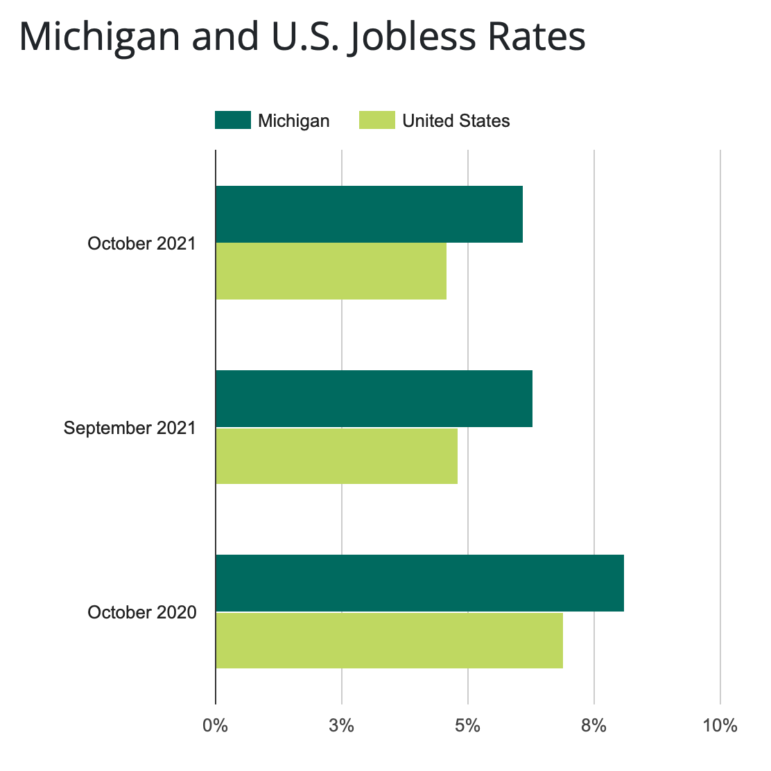By CAMERYN CASS
Capital News Service
LANSING – “Help Wanted” and “Now Hiring” signs make up the storefronts of many Michigan businesses as employers struggle to find employees.
In March and April 2020, the U.S. economy lost 22 million jobs in the wake of the COVID-19 pandemic, but by last month the economy regained 18 million jobs, said Charles Ballard, an economist at Michigan State University.
So, why the shortage?
Some businesses and the Michigan Chamber of Commerce officials blame unemployment benefits.
“I’m afraid that the message, however well-intentioned, sent out by Congress, the president and the governor, was that it was okay to be unemployed,” said Rich Studley, the president and chief executive officer of the Michigan Chamber.

Michigan Department of Technology, Management and Budget Bureau of Labor Market Information and Strategic Initiatives
Michigan and U.S. Jobless Rates 2020-21Other factors contribute to the shortage, he said, but at its peak, unemployment benefits came out to be $16 to $18 an hour, an attractive wage for a lot of workers.
“You don’t have to be a math whiz to do the numbers,” Studley said.
Since unemployment benefits are funded through employers’ payroll taxes, Studley said he worries the trend will continue into 2022 if workers keep relying on these benefits, raising costs for employers.
Others say unemployment benefits are not enough to comfortably live off of.
Unemployment insurance doesn’t come close to replacing regular wages for most workers, said Peter Ruark, a senior policy analyst at the Michigan League for Public Policy.
The maximum weekly benefit would be equivalent to about two-thirds of the average weekly working wage.
“I think we can remove unemployment insurance as a reasonable cause for the inability to attract workers,” Ruark said. “One thing we have seen is that when employers raise their wages and provide better work conditions, the workers tend to come.”
Employment didn’t jump once benefits were cut back in September from the $300 a week bonus during the worst of the pandemic, an indication that it’s not these benefits keeping people out of the workforce, Ballard said.
Recently, the percentage of workers who have voluntarily quit their jobs has been unusually high, something that only happens when workers think they have a good chance of finding a better job, he said.
“COVID has been such a large shock that it has caused millions of American workers to do a once-in-a-lifetime re-evaluation of their connection to work,” Ballard wrote in an email.
Low wages, poor working conditions, early retirements brought on by the pandemic, and ongoing health-safety concerns are major contributing factors to the shortage, he said.
Some emphasize that low wages and poor working conditions are the greatest contributing factors to the shortage.
“I don’t know if I believe there’s a worker shortage or just a shortage of workers who are no longer willing to work for those types of wages,” said Jeremy Tripp, the executive director of Service Employees International Union, Local 517M, a public employee union group.
With recent federal investments in the state, Tripp said he hopes the Michigan Legislature invests some of the billions of dollars into the workforce to improve working conditions and wages across the board.
“For so long, there’s been a lot of low-paying jobs that a lot of people have felt compelled to take,” Ruark said. “Right now, the tide has turned where it’s a job-seekers market.”